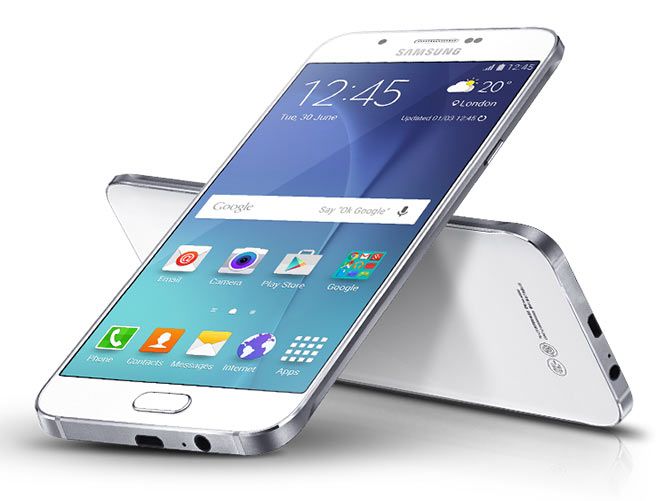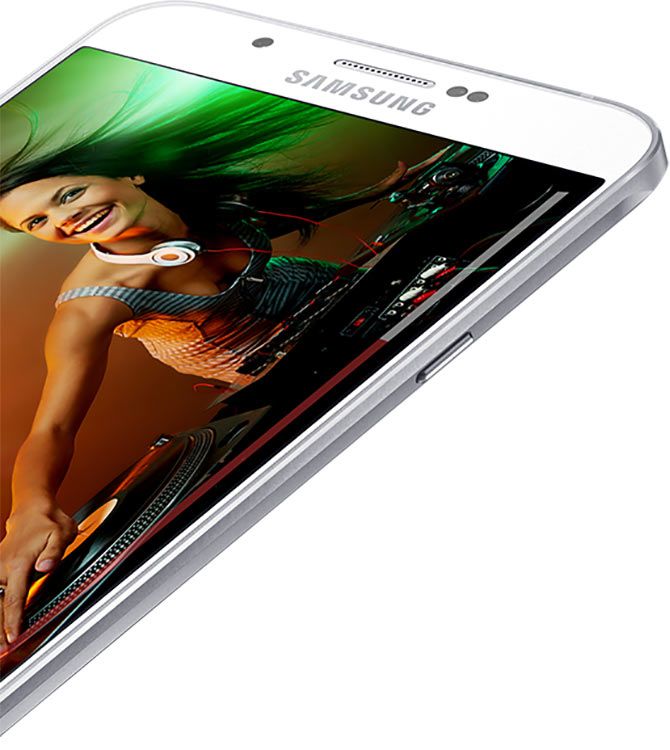At Rs 32,500, the 4G-enabled Samsung Galaxy A8 is only for dyed-in-the-wool fans, says Himanshu Juneja

Samsung has found itself at the receiving end of constant criticism vis-a-vis the plastic built quality of its mobile phones. The never ending jibes, and the onslaught of the Chinese branded mobile phones finally made the South Korean giant initiate the Galaxy A series.
The Galaxy A series is placed just below Samsung's flagship devices, giving the customers the choice to lay their hands on an impressively performing device. The Samsung Galaxy A8 is the latest phone in this series.
With the Galaxy A8, Samsung seems to be making efforts to arrest the slump for its mid-range device share in the market, while enticing the customers who value build quality as an important factor.
Build and design
While creating the Galaxy A8, Samsung ended up manufacturing their slimmest mobile phone till date.
At 0.23 inches, the phone is incredibly slim and gives the look of a well crafted device. The metal chamfered edges and tapering of the sides allows for a good grip.
The bezel has been kept thin, and buttons rendered in metal concur with the general theme nicely. The phone weighs just 151 grams, and it is a huge plus for a phone with metallic construction.
The bottom edge of the phone carries the 3.5 mm audio jack and the USB port. The right edge plays host to the power as well as the volume key, while the left edge has the the dual nano SIM card slots. Upon turning over, one finds the camera lens, the LED flash, and the loudspeaker, all three arranged horizontally at the upper portion of the side.
The back panel is not a metal affair. Samsung decided to go ahead with plastic here, so say goodbye to smudges. The back panel has been made with quality plastic, and unless one takes a close first hand look, the back would easily pass off as metallic. The grippy nature of the back panel helps with the gripping as well.
Display

The Samsung Galaxy A8 comes with Super AMOLED full HD screen. The 5.7-inch panel carries a resolution of 1080 x 1920p, which results in 386 pixel per inch count, which is very impressive.
The screen delivers a superb performance, and can easily compete in the given segment for the award of being the best in the business. The colours came out as vivid and punchy, the SAMOLED nature ensuring the saturation level remained towards a higher side.
Text appeared crisp, the contrast levels brilliant, and with impressive brightness the sunlight readability was not an issue. The viewing angles were pretty good as well.
Hardware
Samsung Galaxy A8 is powered by Samsung's own processor, the Exynos 5430, a 32 bit based architecture, with four cores clocked at 1.8 GHz and another four running at 1.3 GHz. The Mali T628 GPU takes care of the graphics, and 2 GB of RAM completes the troika.
The phone comprises of 32 GB of onboard memory, with users having the freedom to expand it further by another 128 GB via microSD card. But this again comes at the expense of sacrificing the luxury of using a second SIM card. This can be frustrating for the users and add up to the cringe factor. NFC is missing as well.
Also, Galaxy A8 could have been supplied with a 64 bit architecture according to the growing trend. The phone not being a flagship already, Samsung should have taken these small yet critical steps.
Fingerprint Scanner

Pretty much like Samsung's Note 5 and Galaxy S6, the Galaxy A8 gets a fingerprint scanner integrated into the home button as well. The user just needs to place the digit in any orientation, and the phone will be unlocked. No swiping is needed.
Storing of the fingerprints can be a bit longer than expected, but the 'no swipe/orientation required' nature of the scanner should catch up. The phone allows for a total of four fingerprints to be stored.
Connectivity
Samsung Galaxy A8 hasn't missed out on the 4G bandwagon and has made the phone capable of accessing 4G connectivity via both SIM cards. However, only one SIM card can access 4G goodies at a time, while the other SIM will latch onto 3G/2G connectivity.
Other options include Wi-Fi, and Bluetooth 4.1. For GPS assistance, AGPS and GLONASS have been included here. It was good to see the FM radio with recording option being present as well.
Software
The Galaxy A8 comes with the latest version of Touchwiz user interface from Samsung, while keeping Android 5.1.1 Lollipop as its base.
And as has been the trend since past few models, Samsung has gone with a lean interface and held back its habit of unleashing bloat to a good degree. It has handful of its own apps but the concentration is towards enhancing the user experience.
Apps like S Voice, Galaxy apps, Samsung KNOX (the mobile security feature from Samsung), are pretty good. The ability to run multi windows and theming option is something most users will accept with glee. Inclusion of Microsoft OneDrive with 100 GB of cloud space is again a delightful inclusion.
The lockscreen has the weather info upfront and allows for two shortcuts, Dialer and Camera. Once inside, the user will notice the flipboard app on the left panel, providing news feed from the selected sources.
Pull down from the top, and the familiar toggles from Samsung come to life. There are lot of toggles to be experimented around with. One feature which stood out was the Private mode. This mode allows the users to grab hold of user picked files, photos, videos etc and secure them, making use of the fingerprint scanner. To ease off the task of signing into sites repeatedly, Samsung allows the user to let the fingerprint scanner do the job. The user just needs to check the option to remember the credentials using the fingerprint. The next login will take place with fingerprint authentication only.
Although the Touchwiz only apps cannot be uninstalled, the OS experience is impressive and Samsung's efforts to hold back propriety apps shows. The OS is more than manageable.
Performance

The phone overall provides a very smooth user experience with the day to day as well as strenuous tasks. The Exynos processor with the Mali GPU beats the Snapdragon with Adreno variant of the International version, and this was pretty clear especially in the graphics and gaming department.
The device went without breaking too much sweat while churning out the transition or the regular graphic effects. Be it running multiple apps, or switching between them, there was not anything to complain about.
The phone did get warm with prolonged running of strenuous tasks, but this didn't affect the performance.
HD content like games and movie clips ran without any hitch. Asphalt 8 testified to that. Although loud, the placement of the speaker could have been better, as it can get muffled pretty easily.
Camera
If people thought that Samsung might just slip in the camera department with the Galaxy A8, they will be disappointed. The phone comes with a 16 MP camera for the rear version with LED flash, and the front camera is a 5 MP affair.
Both the camera lenses have been made wide angled to soak in bigger fields of view. The camera app is pretty clean and minimal to some extent, as it hides the advanced options away, while giving the more regularly used options space first up.
Samsung got the most useful shooting modes onboard and one gets HDR, Panorama and Continuous shooting and Night mode. Samsung is counting on the users to download other modes of choice.
The missing optical image stabilisation feature was really expected at this price point.
Rear camera can be launched in under a second with the double press of the home button. Capturing photographs in well lit conditions delivered detailed results and accurate colours. Noise was limited. In fact, the pictures were sharp even while shooting in poorly lit conditions. Noise made its presence felt, but so did some good level of useful details.
Dito for the videos captured. Videos sampled from bright as well as poorly lit conditions were packing decent level details. Nothing ground breaking , but good results.
The user gets to shoot only 1080p videos and the absence of 4k shooting option did rankle a bit, clearly reminding of the non-flagship category phone. The sound captured was pretty good though.
The Galaxy A8 has the sort of camera which produces very good quality results, but falls short of greatness.
The front camera is capable of shooting 1080p videos as well, and captures good clean selfies. Aberrations can be touched up with the help of beauty mode.
Battery

Samsung Galaxy A8 comes with a non-removable 3050 mAh battery of Li-Ion variant. Finding a non removable battery with Samsung always is something against the run of play.
Users can rest assured that the battery pack will last more than a day on a heavy usage pattern, and this can even be stretched to about two days if users go a bit easy.
There are the power saving and Ultra power saving modes too. These modes allow only a handful of few critical functions and apps like phone, messaging, memo, clock, calculator etc, thus enhancing the standby time of the device.
The supplied charger makes the battery go from nought to full in about eighty minutes.
Verdict
Samsung has brought forward a well-made device which impresses on many fronts. The fine built quality, near brilliant camera, long lasting battery, will draw the attention for sure. But at Rs 32,500, only die hard Samsung fan may take the plunge.
The competition arises from OnePlus 2 and HTC E9+. The former brings 2k resolution display and a 20.9 MP camera, while the latter has a powerful processor along with 2160p video recording feature and both come cheaper to boot!
Taking these factors into account, the well rounded Galaxy A8 seems pricey indeed, and Samsung should consider bringing in price cuts sooner than it originally planned.









